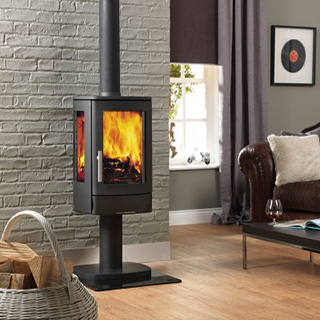Operating and Maintaining your Stove
When getting a stove it is very important to ensure that it is running at its best throughout its lifetime. They need regular checks to see if every part is working correctly and if not a part may just need replacing. Replacing just a spare part can save you a lot of money because there is no need to replace the whole stove.
Flue Outlet
There are two places that the flue outlet can be and they are either at the top or at the rear of the stove. Gases that are produced while burning leave the stove via this outlet and end up in the chimney. They then leave the building through the chimney and according to the building regulations all the gas that is produced has to eventually end up outside.
Throat Plate
The Throat Plate can collect soot that has fallen down the flue. This soot needs to be removed regularly to stop it catching alight and to make sure there is a clear pathway for the gas to exit the stove.
Fire Brick
The Fire Bricks main purpose in a stove is to improve the efficiency of it. They are located in the chamber and to improve the efficiency they insulate the chamber.
Ash Pan
The Ash Pan is simply there to collect the ashes that are made from burning the different fuels. Collecting all the ashes in here makes it a lot easier to remove from the stove.
Fire Door/Window
All stoves will have a fire door and window and to get maximum efficiency they should be tight fitting. They may have a way to adjust it so the door is as tight as it can be. In most cases the door will have a rope seal to make a gas tight seal. These seals are exposed to wear and tear so therefore may need replacing when they are not doing their job effectively. If you use your stove with the door open it will reduce the efficiency and also may cause some damage due to over firing. If the stove has excess air going in it will result in cooling the fire and even letting cold air into the home.
Appliance Controls
The main control that a stove has is the regulation of the air that is reaching the fuel. This will then affect the heat output and efficiency.
Primary Air
The primary air control is usually located in the ash pit door. Primary air goes into the stove below the grate and controls the burning rate.
Secondary Air
Secondary air goes into the stove above the grate and gives the gases that have been produced during the primary combustion oxygen. This improves the combustion efficiency so in result reduces the amount of smoke emissions.
Burn Efficiency
There are three things to look for when wanting an efficient burn of fuel. These three things are time, temperature and turbulence. The burning of the fuels should have time to burn before the flame is pushed up the chimney and the heat that is being produced is wasted. Many fuels burn at the highest efficiency when the temperature is very high. If the temperature isn't high enough then heat will be wasted and more smoke will be released. The air and combustion need to mix to get an efficient burn. To do this the fuel needs to be arranged in a certain way but you have to be careful not to overfill the stove. To get a healthy flame it should be between a vigorous flame and lazy flame. A vigorous flame is where it is reaching the exit of the stove. This is ok when getting the stove to the correct temperature but you should not continue to use it. A lazy flame is where it spreads out over the whole fire chamber. This is very efficient and should be used continuously when at the correct temperature.
Maintenance Checklist
Ensure there is a light bed of ash as wood burns better. However, when burning a mineral fuel you should remove the ash regularly as it reduces the air flow and can cause serious damage.
Ensure throat plates are cleared regularly
Ensure grate and fire bricks are replaced if they become damaged
Safety Checklist
Keep all the fuel away from the stove
Use the right fuel for the stove
Ensure that the external air ventilation isn't blocked
Don't leave an open fire unguarded without using a spark guard
Use a fireguard when there are children around
Get the appliance serviced annually
Chimney Sweeping
When burning wood or coal the chimney should be swept at least twice a year but when burning smokeless fuels it should be swept at least once a year. The best time to get it swept is just before the heating season and if you have to have it swept twice at the end of the heating season.
Fuel
You should ensure that you are using the correct fuel for you stove. When using firewood, to get the best out of it, it should be as dry as possible. Dry wood is said to give twice amount of heat out so therefore less logs need to be used.

